When it comes to triathlon, there are basically two core types of races: Those that permit drafting, and those that don’t. If you watch the Olympics, you see short-course style racing, that permits drafting. Whereas if you watch an Ironman race (such as the World Championships usually held in Kona), then you see non-drafting triathlon, where athletes have to stay separated out of the draft zone (usually about 12-meters long). An athlete can pass another athlete but has to do so within a specified period of time (e.g. 25 seconds), else they can receive a time penalty.
In general, most triathlon events that age-groupers participate in globally are not draft legal. Meaning, you can’t draft. Draft-legal triathlons do exist for age groupers (such as this one I’ve done in Paris a few times), but they’re somewhat rare (likely because most triathletes aren’t great at riding in packs at high speed).
When it comes to long-course triathlon (like an Ironman race), where drafting isn’t legal, it’s penalized when an official sees the action occur. Officials roam on the back of motorcycles through the route as best as possible. But most races will only have a couple of officials on motos, for a course that can be upwards of 112 miles in length (less if loops are done). This makes it virtually impossible to catch all drafting infractions (or catch even a small fraction of them). As a result, purposeful drafting (aka cheating) is widespread in triathlon, especially in larger events where draft packs will occur*.
RaceRanger aims to change that with a new system targeted at event organizers that puts sensors on bikes to not only police the race, but also provide athletes with feedback on whether or not they’re in the draft zone, and how long they have to get out of it. It’s a problem that has vexed triathlon for decades, but this seems like the first viable tech solution for it (some have attempted cameras previously, but only overhead/drone cameras could correctly account for showing separation distance over a multi-hundred meter stretch of roadway).
(*Yes, some courses have non-ideal portions that essentially create areas drafting has to occur due to the number of athletes – such as the start of the race. Hang tight, I explain how the technology handles that in a second.)
The Technology:
The RaceRanger system is comprised of two sensors, which would be loaned to the athlete in their race bag (just like a timing chip is). One sensor goes on the rear of the bike below the saddle, and the second attaches to the front fork (both seen above). They use the industrial-strength and reusable zip-ties to attach. The two devices work together to fork the network on a given athlete’s bike, but also to talk to other bikes passing by.
The rear device (above) has lights on it, which communicates the draft zone status to the rider trying to pass you (more on that in a second), thus there’s no reason for a rider to look at their own lights for regular passes. They’re looking ahead, at the person they’re trying to pass. Meanwhile, the front device also has lights too (and a speaker). Those lights are used to alert you that you’ve received a warning or penalty, in conjunction with an audible noise from it.
Prior to race day, the units hang out in standby mode. But on race day, the units programmatically power on, and the company says they have enough battery power to last the entire day for the slowest allowable time of an athlete at a long-course iron distance event (17 hours). It’d be up to the race organizer to do the charging of all the units ahead of time (wirelessly). Note that while the device would of course have an aero penalty, that penalty would be the same to all athletes (just like a race bib), thus, it’s basically zero-sum there.
Out on the course, as two riders get closer, the units start communicating with each other. This is done via Ultrawideband (UWB), Bluetooth, and LoRa. Though the units contain an alphabet soup of technology, including also GPS, NFC, accelerometers, and wireless charging. At present they don’t contain cellular technology, though it sounds like they’ve got some ideas in that realm. In fact, the devices are circular in shape as a way to bend the four antennas around the device (GPS, UWB, BT, Lora).
Once the following (rear) rider enters the draft zone, the light signal on the bike *in front of them* changes to a red rapid flashing light. The company says their technology is accurate within 10cm, thus more than enough to enforce the 12-meter long draft zone for an Ironman event (or even a 7-8m long zone as some other events have). Here’s a screenshot from their detailed video they have:
As the following rider completes the pass the lights switch to blue. And then at that moment, the roles reverse. The now-passed rider is in the draft zone and needs to fall back out of it (within the allotted time, 25 seconds in the case of an Ironman event).
Should an athlete not complete the pass, then the system logs that, and transmits it to the official.
This is where things get pretty interesting. The official can be upwards of 5KM from the athlete when the information is transmitted to the tablet:
At that point, the system has the flexibility to do a myriad of things, depending on how the governing body or race organizer sets it up. It could automatically give the athlete a penalty, or, it could notify the official that there’s a given athlete that’s worth going to and following for a bit (to perhaps hand out a manual penalty).
In fact, the system also tracks so-called ‘yo-yo’ attempts. Where an athlete enters the draft zone constantly but doesn’t actually make the pass. In triathlon, once you enter the draft zone, the only (legal) way out of the draft zone is by completing the pass. Else technically, it’s a penalty. Of course, there are scenarios where the lead athlete could get penalized (such as purposefully blocking the passing athlete). And that’s where the system is probably best run in a manner that aims to make athletes give thought, rather than instant penalties. The official is never shown the name of the racer, just the race number. This allows them to look at that list and say “Huh, Racer #423 has been in the draft zone illegally 8 times today for an average period of 72 seconds each time, maybe I’ll go follow them for a bit”. The tablet is sorted by distance to the moto.
Still, if run in the instant-penalty realm, then the offending rider will get an audible alert, as well as a flashing yellow pattern of lights on their front sensor at their fork:
And then later, as they pass by a penalty tent, the system will automatically show the athlete that they have a penalty:
Oh, but you just wait. Not only does the system detect the original draft penalty, but the penalty test itself detects the exact time the rider is serving in the penalty tent itself. Thus counting down the time until the rider is allowed to leave. This sounds crazy, but it makes sense – after all, it’s pretty easy to detect that in this case.
Now RaceRanger says they understand that many races have sections of the course that make it virtually impossible to avoid drafting. For example, the start of a race is a common area where drafting can be challenging to avoid, especially in a mass start event. The same goes for steeper climbs, or even mandated slower sections of a course (some steep twisting descents). For that, the system can assign no-policing zones (seen in yellow below)
And even with those zones, the company notes that it won’t solve every scenario on every course, saying:
“Ultimately, RaceRanger is not a silver bullet to the issue of overcrowded race courses. The responsibility lies with event managers to address this issue, as it does today.”
Down the road, the company also sees the value of live tracking, given the GPS onboard. Not just for spectator tracking, but also for live broadcast scenarios. We’ve seen a rotating door of companies trying to provide not just triathlon, but cycling too, with live-tracking functionality that scales across vast courses with huge numbers of riders. To date, most of those companies haven’t survived more than a couple of seasons. Unlike most other sports technology, the device purchase here isn’t targeted at the end-consumer, but at the event organizers. That in turn makes it a trickier play.
Now before we talk next steps, I’ve gotta give this company credit for putting together what is *BY FAR* the most comprehensive FAQ list I’ve ever seen. Seriously, you have to check out how detailed this list here is, including my favorite on what happens if you like to draft: “Tough biscuits my friend.”
Next Steps:
So all this sounds great in practice, but, in an equally food-related analogy: “Where’s the beef?”
Does it actually exist? The company says yes. They’ve been building out the platform bit by bit for over 6 years now, you can see one of the prototypes above.
They plan is to start trialing it in races in January in New Zealand, where they are based, for summer triathlon events. From there, based on rider, event organizer, and sanctioning body feedback, they’ll make tweaks. And then ultimately they want to start full-scale manufacturing in the second half of the year. They note that there are areas they just need real-world feedback on, such as what athletes think about the light system after sitting on a bike with hundreds or thousands of others and lights for 5 hours. Additionally, they know that some countries don’t permit blinking lights on roadways, as an example of an item still to sort out.
However, the company got a boost yesterday with an endorsement from World Triathlon, the governing body for triathlon announced support of it, including having assisted RaceRanger in testing and development:
“World Triathlon is one of the most progressive and innovative sporting organizations in the world, and we have proved this approach multiple times. With this agreement with RaceRanger we want to make the athlete experience better, providing new technologies that will increase the fairness of the competition for all athletes, especially the ones competing in longer distance formats”, said World Triathlon President and IOC Member, Marisol Casado. “I am really proud of our involvement in bringing the RaceRanger project to life from the beginning, supporting new ideas and technologies that will help develop our sport and make it even more accessible for all in the near future”
I could also see though this technology being acquired by one of the race companies out there. Assuming it works as described, it’d be a significant competitive advantage to have this supplied at races. I could easily see competitors looking at something like this and saying “Oh, Challenge or Ironman has RaceRanger, thus, I know the drafting will be significantly less there.”
I could also easily see a Garmin or other sports tech company picking up this technology to license (and I’m sure there are countless other non-triathlon use cases as well). Either scenario would likely increase the chances of commercial (and technical) success here, simply due to added funds and visibility.
Ultimately, the company says their “roadmap has us on track for full-scale use in mass age group fields of up to 3500 athletes from April 2023”. Hopefully, that turns out to be the case. I’d say this is one of the coolest and most interesting sports tech things I’ve seen this year, if not in a few years.
With that – thanks for reading!
FOUND THIS POST USEFUL? SUPPORT THE SITE!
Hopefully, you found this post useful. The website is really a labor of love, so please consider becoming a DC RAINMAKER Supporter. This gets you an ad-free experience, and access to our (mostly) bi-monthly behind-the-scenes video series of “Shed Talkin’”.
Support DCRainMaker - Shop on Amazon
Otherwise, perhaps consider using the below link if shopping on Amazon. As an Amazon Associate, I earn from qualifying purchases. It doesn’t cost you anything extra, but your purchases help support this website a lot. It could simply be buying toilet paper, or this pizza oven we use and love.

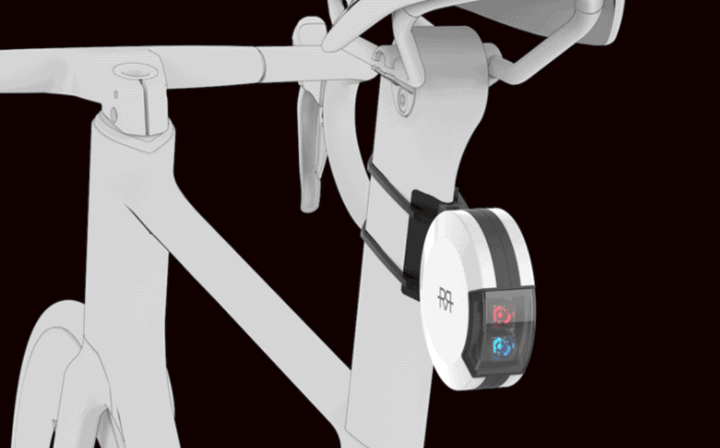
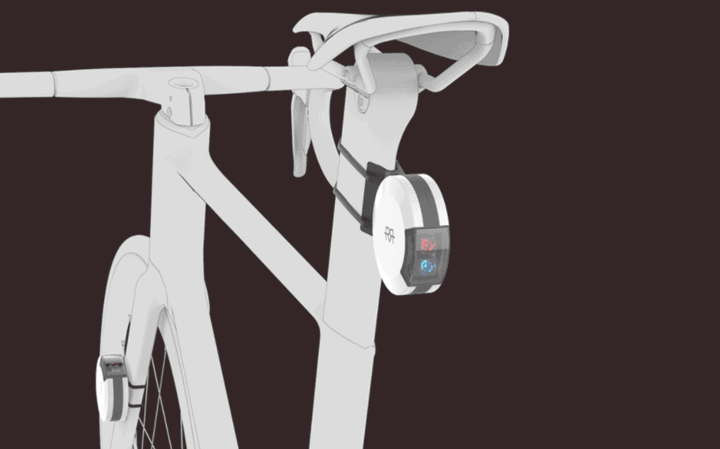
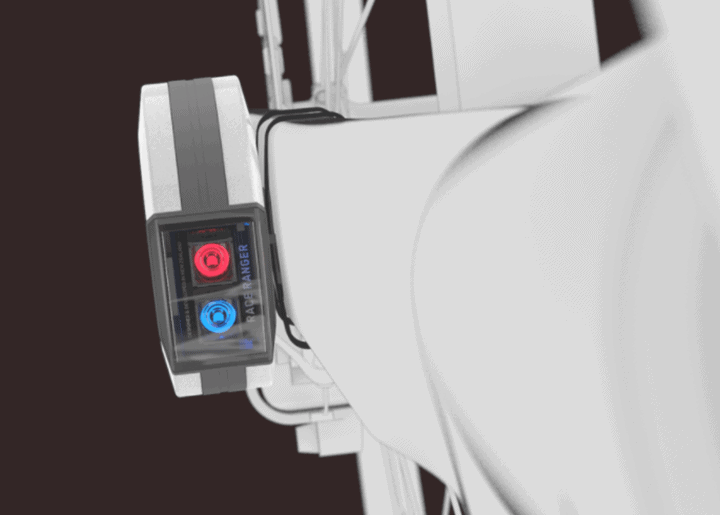
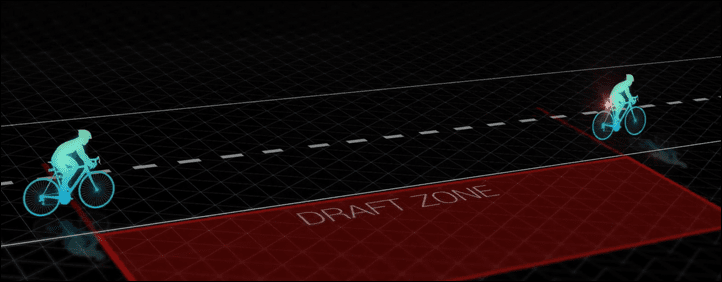
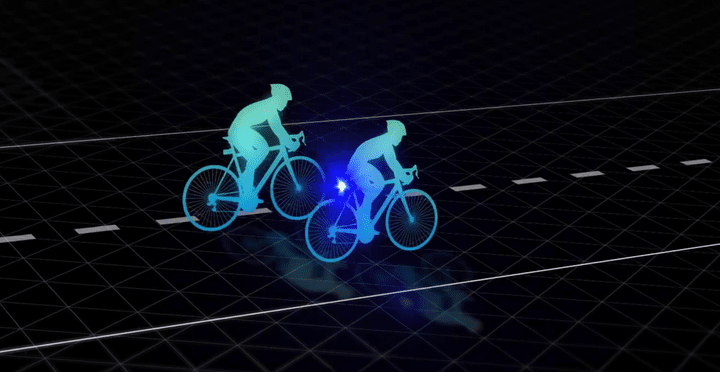
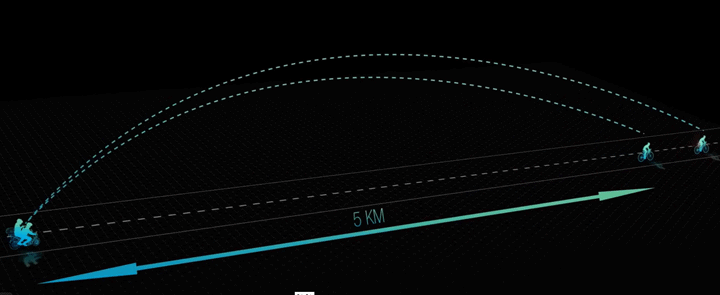
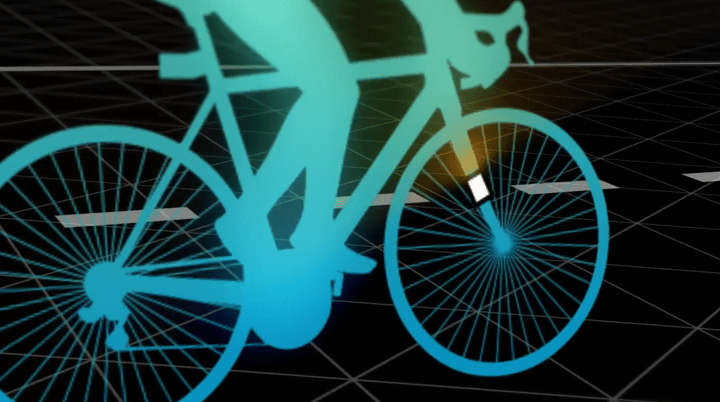
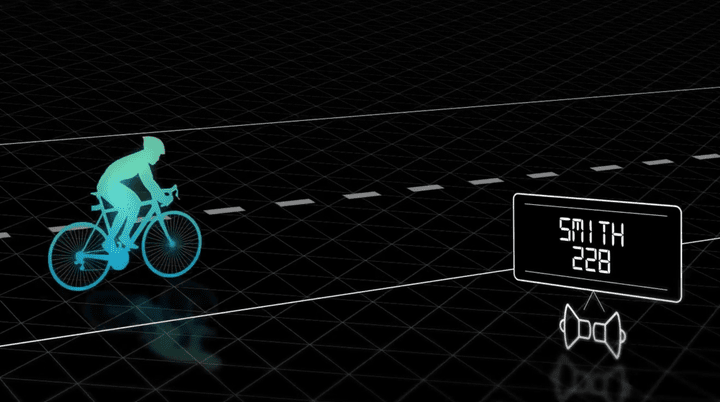
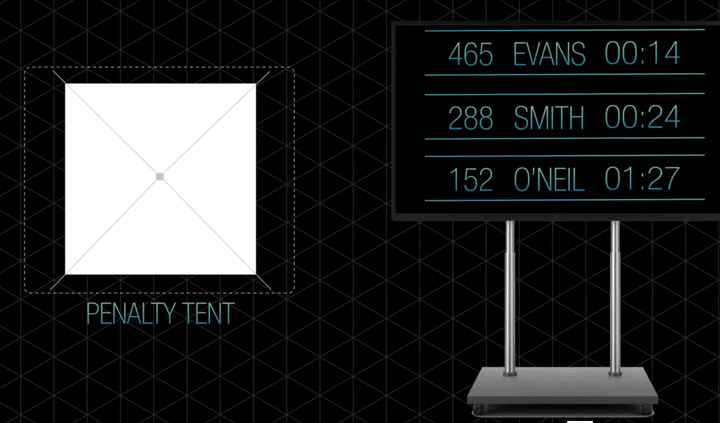
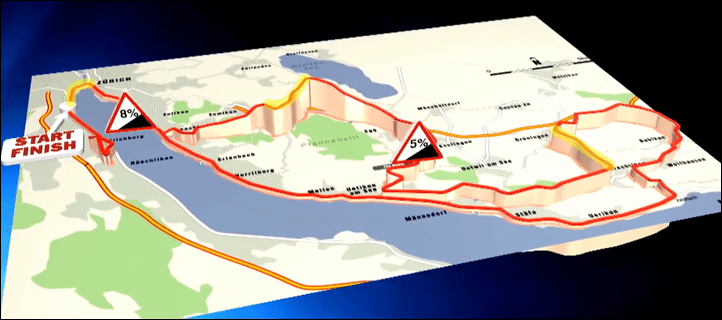
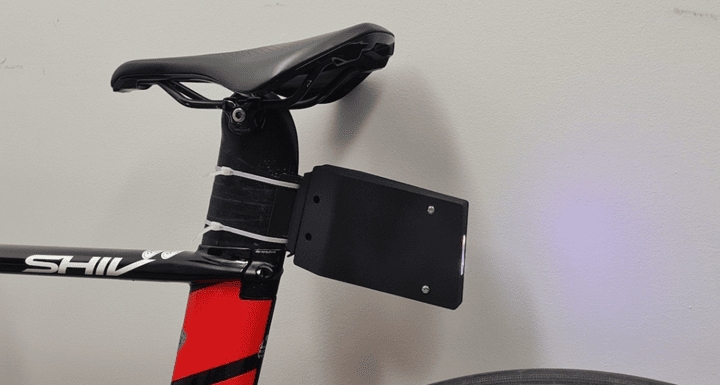
















It should communicate to the bike behind and override DI2/eTap gear selection to solve the problem… 🙂
Would like something that tells me if someone is sitting on my wheel while I am training
Or, you know, just somehow electronically opens up a small spray-bottle of Liquid Ass for the person behind you to ride through (I’m not kidding, this is a real product with like a thousand reviews: link to amzn.to)
Just launch a strategically targeted snot-rocket.
“Oh, I’m terribly sorry. I didn’t know you were there”.
May I suggest a bar-end mirror? I quite like the ones from Sprintech. Also very useful for situational awareness (ie before making a left-hand turn)
It’ll work for some people, but others will need to rearrange their setup for this. How much you want to bet it’s not just really, really, short people who’ll get impacted?
From their FAQ:
Athletes often store drink bottles, spare tubes and equipment in this area. We have walked transition areas and assessed entire long-distance fields of up to 1500 bikes to get the best understanding of the requirements in this area. Smaller athletes with very little seat post exposed from the frame (seat very very low), who also store a lot of gear behind the saddle will likely need to rearrange some items to allow the RaceRanger system to function
Yeah, I suspect once they get into real-world trials some aspect of the mounting kit will change. My bet is that they ultimately end up having 2-4 different rear-mount options – similar to what we’ve seen from other companies over time.
As someone who has tried all sorts of ways of trying to fit a light to the back of my Speedmax with the Canyon seat tube mount rear bottle rack holder thingy on this will be a serious problem – and given how many Canyon’s there are that’s a lot of people. Even looking at Frodo’s bike when he has the bottle mount on there isn’t loads of room – and I don’t think he’s a “smaller athlete with very little seat post exposed”.
Also – zip ties????? Whilst I appreciate that the impact of zip ties and the fork thing isn’t necessarily going to matter and is “the same for everyone” (that’s not really how aerodynamics works but happy to go with it because we probably aren’t talking about much) – are people who spend heaps on expensive bikes really going to want to junk them up for “no drafting” – after all, the Tour de Barcelona, sorry, IM Barcelona, sells out every year with people going for a “fast time” – they know they’re going there to cheat, so I’m not sure that eliminating drafting is really something that is necessarily a big selling point for at least a significant number of athletes (especially as presumably events that buy this will end up being quite a bit pricier).
Yeah, that’s where I really think the main potential here is big race series coming in. For example, if Ironman comes along and says “We’re going to have this in all races by 2024, required” – that’s going to very quickly force the hand of the Canyon’s of the world to ensure bike compatibility and retrofit kits (either provided by the race or otherwise).
Certainly, some people will always want to cheat. We can’t really solve that desire. But having spent enough time on ST over the years, I know that the vast majority of people don’t want that, and are tired of drafters (and were tired a few decades ago).
As for zipties, ultimately, there are plenty of solutions that can be made. But the WorldTour Pro teams use zipties for race/timng chips, so…
Vast majority of Triathletes don’t live on ST like you or I do.
I’m an IM athlete and I’m not a drafter. But I also don’t care when another athlete wants to draft. It doesn’t influence my achievement and that’s what I’m working for at that moment. I’m absolutely not interested in how ‘the other’ is achieving his his goal.
The biggest ‘problem’ is that the pro’s may draft in OD’s. That’s what people see on TV as an example.
We may draft in swimming and running. So don’t be so selective offended when someone is in your wheel. Just push a little harder when you get annoyed.
Same here. I always wondered why drafting is considered legal for the swim, but is not for the bike?
I wouldn’t draft on the bike but more because of safety: getting to the brakes from the aero position takes a few seconds, so if you draft someone too close at a high speed and something happens, you may crash… For me it makes no sense to risk losing minutes in a crash or not finishing the race only to chase a few seconds by drafting…
why drafting is legal for the swim is probably due to enforceability, logistics and legal liability.
1) How to enforce swim draft zones, I won’t be able to tell a whistle aimed at me vs. someone behind me? point with a long pole? What about water conditions with near zero visibility?
2) How much longer will you need to have water safety crew?
3) if a swimmer has to slow down, maintain draft zones, and then has an incident, who’s liable. Most AGers are bad spotters, what happens when someone keeps swimming off course and gets exhausted?
I think that’s a bit mixed. I am mid to back of pack, and have found draft packs a non-issue but wheelsuckers frustrating.
I had a few races where someone stays right behind my wheel (who cares). What does get a bit annoying is that the person who stay a feet or two behind through tight corners, making me concerned for my own safety and keep looking back to signal I am slowing down.
The person would also peak out to pass me (fine), but can’t keep the pace / immediately slowing down, and forcing me to either slow down, or surge to pass. Makes
These are very good points and I agree with you that enforcing no-drafting on the swim would be impossible.
But enforcing no-drafting on the bike has been less than ideal and spotty at best, so why even bother?
Technically I think the idea behind makes absolute sense…
But now you’ve bought the most aero bike you can afford to “Save some of those watts and finally get my PR” and they come around and plunk some sensor on your fork, completely undoing the aero work the bike company did.
I know I wouldn’t be too happy about it, especially if I now also have to re-arrange my bike after training in that setup for many months.
Or maybe I’m just getting old and grumpy? lol
At a basic level, if all riders have the device (and all would need to have the device), then it’s a wash across everyone.
In a technical sense, there would be slight variations between placement of such a device on different frames/body types/etc… But that’d be no different than a race number flying off the back, or a race bib.
As you hint- Why not just add this function to Garmin Varia?
” entire day for the slowest allowable time of an athlete at a long-course iron distance event (17 hours).”
Hey, if you are not in the top 25% of your age category, who cares? If you are making up time you are passing, if you are not then you are just trying to survive. Intermittent drafting is not that big a deal if you are just trying to finish.
True, even more so since most races require athletes to make time cut-offs, having someone get off the bike in a worst-case scenario around 5-6PM.
But I think they’re just talking more generally at this point in terms of battery life being important. I’m sure there are other non-IM distance use cases that might require long battery life that I can’t think of at the moment.
With some minor modifications it seems like this could also be used to deal with the “female racer getting help from several male domestiques” issue that gravel racing is wrestling with right now.
The technology is super-interesting, but personally I think the no-drafting policy should be really enforced for the top spots in AG and the Kona qualifying spots. As for the rest, who cares? It’s pretty much a no harm, no foul scenario…
With that in mind, I believe it’s easier for IM or any race manager to have more officials at the lead of the race to monitor the people competing for these spots (or those who are on pace to finish under 10h-10h30, depending on the race), rather than paying for devices for all competitors + getting in the logistical nightmare of checking, charging all the devices, etc.
And as some have also pointed here, with the bottle racks behind the seat post or boxes like on the Canyon or QR bikes, I am not convinced the installation will be practical. My answer would be a big “hell no” if you ask me to take out my 2 bottles in order to install that device instead…
I wonder how this would work when more than one person is passing. I’m an older triathlete, but a strong cyclist, which means I often start at the back and spend much of the bike passing people. It is fairly common for me to pass someone who is also passing someone. Would the technology be able to sort that out?
Same. “On your left, on your left, on your left,…”
As a horrible swimmer, but top 5% cyclist who easily passes over 300 competitors on the bike, and spends upwards of 30 minutes *legally* in people’s draft zones, I’d like to say I’m super in favor of strict enforcement of draft rules for the lead pack, LOL.
Thing is if you’re that much of a horrible swimmer, you’re probably not going to end up in the top 5 of your AG – so then who cares if you’re drafting… On the other hand if you’re only 5-10 minutes behind the top of your AG when you get out of the swim but you’re a really strong cyclist, then you will catch up and be in the lead pack soon enough – where anti-drafting rules should be rigorously enforced…
I don’t think the people who make top 5 of their AG rely on drafting – it may happen )incidentally or not) but I’d be surprised… Then again I would be absolutely pissed if I just missed a Kona spot for 2 seconds and it turned out the difference was because the guy in front of me had drafted at some point…
I swim sub 40 so about 10 minutes behind the top 5 in my age group (50-54). But I also start 20 mins later in timed starts so no way I’m going to make up the 30 mins to the lead group in the bike. Im literally passing 25% of the field at 4-6 mph.
Clarification: sub 40 in the 70.3.
Anyways I’m absolutely not top 5. Someday I’d love to get there though, and as someone for whom it is basically impossible to break the drafting rules because of my relative bike speed, this wouldn’t hurt my chances.
Other way around for me, I swim in 55 and spend time applying my brakes to get out of drafting zone for quite a number of passes…of me🙄… never found a way around this than to increase my bike practice and become faster so that I am passed by less🤣
I’m not remotely interested in this. Most athletes complain about how expensive triathlon is, this would increase the cost of an Ironman by $200 easy. IM or the licensed IM race promoter will not eat this cost, they will past that down to the customer.
I would rather pay more for an Ironman if it meant there were 500-1000 less slots in a race and you have a capped field of 1500. But you’d need no three loop courses anywhere. It would have to be single loop for a 70.3. I’m fairly certain that most triathletes are unwilling to shell out an extra 100 for their race if that meant there was funding for 100 more drug test slots either.
100% agree with what you said.
And I am not that convinced that drafting makes such a big difference over a 9h-10h race compared to other forms of cheating, like performance enhancing drugs…
I would say I’m not interested in this technology, but until it becomes cheaper and less disruptive (no need to reorganize your rear bottles rack), I don’t believe it will be viable…
Seems like a high estimate. Let’s say it’s a $2k device that can be reused 200 times over 5 years. Only a $10 cost per race.
There’s no way this is a $2K device.
Parts-wise, my guess is a $300-$400 retail device – maybe far less. Really depends on what the BOM looks like and volumes. Since they’re selling direct, that’ll remove some of the margin they’d have to give to distributors/retailers.
(Also, I could be totally off and them say “Oh, we’re talking like $100/unit” – stuff like this can be tricky to mentally price since I don’t know some of the component pieces as well.)
Either way, let’s assume $400. In that case, a device would hopefully be used a boatload of times. Which is really why I think the market here is major race organizers that host many events per year. It’s not a one-off event. It’s gonna be at scale. *OR*, it’s gonna be something that World Triathlon or other federation bodies basically rent to race organizers.
Either way, I don’t think we’re talking massive cost increases to competitors here.
The cost would probably be more in term of maintenance, servicing + the logistics to ship them from race to race (which granted, IM could handle easily), charge them… Also how sturdy would these units be? Would they be easily damaged in case of a bike crash?
Yup, probably a service agreement of sorts.
Again, I’ve got literally no idea how much this could cost – I’m just pointing out I can’t think it’d be anymore than $300-$400.
Nothing on that list of components sounds expensive if mass produced. So a company like Garmin, which already has virtually all those components in other products, owns their own factories, could come along and say ‘Oh, our BOM is $76’, retail it for $150 with a min order of 1,000 units, and then some sort of services thing to cover it. I don’t know, just finger in the wind wags.
2 units per person. And I am assuming the front and rear units are slightly different, it isn’t clear from the write-up if they are a pair or twins?
Given battery life on similar sized and equipped tech they are going to need replacing every few years.
However you price it, it is another cost that is going to tip the balance for some people.
OK. But how many could they sell? I’d assume there is demand for no more than about 5000 units globally on any given weekend. If they last a year and they are selling them for $400, there’s very little business model on the sales side. Wouldn’t you think that with such a low volume item, the capital/manufacturing cost would be much higher per unit?
Even on the service side, $10-20 per athlete is pretty thin, even if they can handle the the mechanical logistics efficiently (eg 5 mins per bike).
But with the gps and all the potential for exciting real time race analytics (position, speed, time in draft zones, risk of penalties, etc), the potential for increased viewer engagement might be real, and maybe they can get more?
MSRP for a Varia is $200, this goes beyond what a Varia does. But let’s say each set is $400. They’re not just selling devices. As they’ve stated on ST, they will be a service that is contracted out where the race promoter has to have a subscription to their platform to use the devices. Better add a couple zeros there.
So they’ll sell a software package with a subscription, and then a service contract to service units.
The Official Ironman Mechanics will have a field day with this. Oh, you don’t have the special Cervelo RaceRanger attachment? I can do that in 3 mins for only $250.
Pair it with something like an AirHub and make it automatically apply a resistance penalty to drafting scofflaws.
Great, but it is still never going to work. Some issues:
Athlete 1 is going to get into the zone for an overtake realise they are about to time-out and get a penalty, sprint till the lights go blue, Athlete 2 now has to back off, but they have to back off from Athlete 1 who is also slowing because he gassed himself with that sprint. (n.b. this has always been the rule, and a potential effect but in reality, either Athlete 1 just takes longer to overtake safely, or if Athlete 1 screws up their overtake, Athlete 2 just rides on at their normal pace without being affected or penalised).
Athlete 1 manages an overtake (just) but then slows RIGHT down for a puncture, maybe even stops. Athlete 2 can’t get out of their draft zone without stopping dead or potentially even reversing.
Athlete 1accidentally gets into the zone while following at the limit (potentially because Athlete 2 dabs the brakes or goes for a gel, or anything else that slows them a tiny amount). Athlete 1 no longer has the option to just sit back and fall out of the zone, they have to attack, or they get a penalty. Again, penalising one athlete for the actions of another.
Athlete 1 goes legally around the side of the draft box on a wide course but takes more than 25 seconds to do so. Penalty issued despite no offence being committed.
They don’t actually seem very clear on resetting the 12m distances so while that may be in the system, their FAQ only really covers Ironman events under Ironman drafting rules.
Lots of courses avoiding drafting for large chunks of the course is impractical (not impossible) at what point do you decide that the yellow-zones are so much of the race that the whole system becomes pointless.
And so on.
This is a solution looking for a problem. If you are drafting enough for it to be significant, then you know you are cheating, and so do all those around you. This is just going to encourage those people to find other ways to cheat. And as a race organiser, if you can afford the kit, you are upping your prices and scaring off even more customers from what is already an expensive sport.
Had not thought about the ‘lead’ cyclist hitting the brakes (or slowing for a road hazard or getting a drink) and putting the trailing cyclist into the draft zone. Unless there is some cushion/flexibility built in, you almost need a yellow light that is triggered just outside of the draft box so that a trailing cyclist could avoid a required pass for the sake of a cm. Of course, that would also be the signal for the best legal drafting position. 😉
All of these scenarios sound like they need real-world data to confirm them as real-world issues with the system. And more importantly, the ability for the system to work in passive mode, and priotize repeat offenders to the officials.
I think that’s probably the mode the system will stay in for some time. I don’t think anyone is out to try and give penalties for being in the draft box 1-second too long in a hazardous area, or because of some fluke.
I think the idea is to have the system boil to the surface repeat offenders within a race (especially an iron-distance race), to allow the official/moto to follow for a bit and see what’s happening. The mere act of a moto hanging alongside an athlete for 60 seconds and making eye contact a few times is often *MORE* than enough to squash that behavior for the rest of the race.
I am not sure if this technology is even desirable from a commercial standpoint. I’d venture to guess that the vast majority of triathlon revenue come from age groupers. For age groupers that are not competitive (middle and back of pack), I think a lot of people considers the triathlon event more similar to to Tough Mudder / Spartan. I don’t see enforcing draft rules helping triathlon’s bottom line, and triathlon races aren’t money making machines to begin with…
However, I think there’s a lot of opportunity in
1) Pro field (draft packs do form in non-drafting events….at legal non-drafting distances (or otherwise)
2) Live tracking -> makes the event and easier to live with for family members who have no interest in the sport
… or on another thought… if you can gamify it -> Medal for not triggering the sensor rather than penalty for drafting… but medals costs money…
Dimension Data – now NTT – still provides live tracking of road cycling at the Tour de France.
Garmin does live tracking and IM already has a live tracker for their races…
Well, in the case of IM, they sense when you cross each timing mat… doesn’t exactly make for a captivating viewer experience.
For IM it’s a bit more than that – they had 6 intermediate points on the bike on the last one I did. But if you want “true” live tracking you’re better off with Garmin or Garmin-like devices… A wearable like would provide live tracking on the swim and run – whereas this device would be for the bike only…
The cost of chip systems end up increasing the cost to event organizers, and that trickles down to entry costs.
Given the outrageously high cost of Ironman branded events already, don’t want new tech to increase that.
A key feature: warning before you’re about to enter the zone.
When racing I find it hard to estimate distance, so when in doubt that I might have transgressed I just push a little and pass. That can mess with pacing. I’d love to avoid that uncertainty, and similarly I’d hate to be surprised, “whoops you happened to drift into the draft zone, gotta pass now!”
Should be easy enough to add.
Apparently they are planning 2 and 4 meter warning zones before you enter the draft zone: link to triathlonmagazine.ca. Seems like a great addition to me.
If drafting is unfair then surely riding a 15k bike is unfair? Think it’s all unnecessary for 80% of the competitors in these races . Sure do it for the pros but the vast majority just want to get round the course and finish it as best they can without any added stress of lights/ time penalties to do deal with.
The pro field is exactly who I’d say this needs to focus on. Taupō has seen some ridiculous drafting before.
Hi Ray,
Any insight if there will be early Black Fridays sales this year? Read somewhere that retailers may do it earlier to ensure items can arrive before Christmas.
Thanks!
Ask and you shall receive! Here’s the first go at Black Friday sales. Still working on adding things in as we speak, it’s a long list (especially from smaller companies): link to dcrainmaker.com
Great to see this, especially here in NZ – some of the drafting I saw when I was doing IMNZ in 2016 was absolutely unbelievable in how flagrant it was. I hope this sorts it out.
BTW I think you underestimate just how many draft-legal triathlons are run – there are loads here in Spain.
Yup, they’re more common in Europe at the shorter distances, but rarely the longer distances that this is aimed at. In the US/Canada, they’re virtually non-existent.
Hell yeah.
I’ve been waiting for this for the last 20 years.
As a strong AG biker of around 5 hrs who sees ALOT of drafting towards the front of IM races this or something akin to it is EXACTLY what I/we need to ensure fair competition.
I’m even happy to get dinged by accident (my mis-judgement or their teething problems) a few times as I know that the serial offenders I repeatedly observe (mostly in the top 20% of folk looking for slots) will easily be caught 20+ times in an IM and I will see a net benefit to my finishing position as a result.
I can’t wait to sign up to races using this. 👍
On race directors discretion, there’s also no need to DQ people anymore as they can sit in the penalty tent serving their 20x 3minute penalties for the next hour. The punishment will be exactly proportional to the crime(s).
And the reason I never enter Barcelona or similar flat bike courses in Spain and similar areas (despite those courses suiting my 85kg frame), the drafting.
If they implement these systems I think athletes will quickly vote with their feet, esp if races wanting slots must use this type of technology.
A firm thumbs up from me and the many racing folks I know care about fair competition. 👍
a 5 hour bike split and also see 20% bikers drafting towards the front (so passing you ?)… Then there a lot of better cyclists then you are 🙂
I would focus more on my own biking then
He’s referring to the fact that drafting tends to be more purposeful in that top 20% looking for a slot.
Ultimately, if you’re looking for a slot – then what people do around you matters. If people are constantly drafting, that does impact your day. It impacts your ability to get that slot or podium spot. Thus, it’s cheating.
I guess I’m perplexed why some people are for cheating. There’s likely literally a far bigger impact to drafting your way through an IM race than some performance-enhancing drugs but riding solo. The benefits of the draft are massive in comparison.
Hi Ray, I totally disagree that it is cheating. And I’m not a drafter.
But I also don’t care when somebody is at my wheel. I will outrun him anyway 🙂
Drafting comes because of the pretty short round on the bike and thousands of participants. It comes with the sport and the negativity it brings you will take away the joy the sport should have.
At the finish of an IM all will be settled as it should. You will have your slot when you were eligible for it. If not, someone else was better that day.
And what will be the next thing ? No drafting during running ? For sure it is beneficial when you’re at someones heels (probably mine)
There are plenty of courses where space isn’t a problem. So that’s not really an excuse.
This isn’t some new rule, no drafting on the bike been the cornerstone of IM racing for decades. And ultimately, it’s the cornerstone of whether or not someone deserves a finisher title. If you’re doing 10-30% less work on the bike, then that impacts how you run (there’s a reason the saying is ‘To get faster on the run, you have to get better on the bike’). That means the cheaters take the slots for less work effort. They didn’t have a “better day”, except for avoiding getting caught.
That’s not to say all slot takers cheat – hardly. It’s to point out that significant time drafting is a big deal towards the front end of the AG pack. I guess I’m still having a hard time wrapping my head around why folks would encourage cheating – I mean, a sport isn’t a sport (any sport) if not for agreeance on rules. Else, why not just get in a car for a few miles?
I am usually in the top 10% of my AG, and I certainly wouldn’t condone cheating. The bottom line is that if it’s defined as “not legal” in the rules, then you shouldn’t do it.
That being said, I wouldn’t judge too harshly someone who’s in the middle or end of the pack and doing it just to complete the race. Yeah it’s still cheating, but in my opinion the severity of the offense is not the same if you’re cheating to get one of the top spot, or cheating only to survive and finish the race.
Someone racing “honorably” has a right to be pissed if he gets cheated of a top spot or a Kona slot by someone who drafted – I know I would be. But call me naive, I believe that the people competing for these spots have put the work in and are not relying on drafting…
At any rate, I find the technology super-interesting and I would be in favor or implementing it – as long as the additional cost in the entry fee is not prohibitive and the setup could be tweaked to still allow to have rear mounted bottles…
95% of drafting in a long course race is due to design flaws. Either too many laps or too athletes plopped onto the course. See IM Barcelona 2800 athletes between 70.3 and 140.6 BUT 3500 athletes from the Bike-Run race that the promoter imposed upon the Ironman race, they did the same thing at Mallorca.
Just asking as I don’t have a really good notion of the benefits of drafting: don’t you need to be pretty much wheel to wheel or within 6 inches to get most of the benefit and the 30% less work you are mentioning? If the drafter is 4-5m back, are there still benefits? The 12m seems a little extreme… is there a study of some kind that quantify the drafting effect depending on the speed and distance between draftee/drafter?
No, just no. This is a solution in search of a problem. I’m not putting your shit gear on my bike.
I’m not as optimistic as you are. I think market forces are going to make it very difficult for this company to be sustainable. Yes, IM and Challenge could be major buyers. Maybe. For them to buy (or rent) they’d want to see this be a major driving force into why people aren’t doing their races currently. Does it solve a problem? Yes. Does it solve a problem that limits profits? Doubt it.
Other smaller race organizers really don’t want to penalize their athletes. They just want them to have a good time and come back next year. You could probably go to your small local triathlon, draft all day and then high-five the race director while holding on to the bike in front of you with the other hand without getting so much as a warning.
This is a pretty small market. Even if the technology, product production and roll out go smoothly, it’s going to be an uphill battle for this company.
I’d love tech like this to be coupled with a refinement of the rules for races that use it. The 5min/infraction penalty is a blunt tool designed for intermittent enforcement – most of the time there’s no eyes on riders, so the stick is made big enough that most people who might consider cheating don’t want to risk trying anything in the off chance there is. Marshals have to use a lot of discretion to separate inadvertent violations (eg bunching up due to overcrowding) from malicious ones. Under this regime it’d be difficult to use it in any way other than the advisory mode that simply redirects a marshal.
With strict enforcement and technology like this, it could be treated less as a punishment and more of a method to simply erase the benefits. Rather than harsh penalties or threat of DQ, they could do something a little more nuanced like add 20% of the time in violation to your race time – short inadvertent time in draft would just add seconds and be insignificant, but anyone actively trying would lose any advantage they might have gained so there’s no point to doing it. It also resolves the issue that unintentional infractions from things like overcrowding still give a benefit, so if the percentage were set appropriately this could negate that without being punitive.
Heck, given this device knows your speed and the precise difference the percentage could even be scaled based on the potential benefit (ie someone drafting 40km/h 5m back gets hit more than someone going 15km/h 11m back). It’d never be perfect as the benefit gained from drafting depends on a lot of variables (wind, CDA of bike+rider, etc), but if you set it based on the largest possible benefit for the scenario that would likely be sufficient.
A few thoughts:
1. In order for this to work, I think they’ll need zero false positives. The moment they do get a false positive they’ll lose credibility and I suspect it would take a long time to get it back.
2. I’d lean towards using this to catch the worst offenders and use it to alert a human to intervene. I seriously doubt many people can tell whether they’re 11.5 or 12 meters back from another cyclist when they’re fatigued and moving at 25 mph. Once they’re within 12 meters they have to pass and I don’t think think this is best served going after someone 11.5 meters behind. Instead it’s better to go after those that are worse offenders. Perhaps they could have an algorithm to determine how severely someone is drafting and have a ref focus on those ones.
3. If this is implemented correctly I believe people will love it. At first many will get caught, but eventually people will learn and draft less.
4. Saying the device will be zero sum for 2 different bikes may not be entirely true. The sticker you put on your bike fits completely around the box on my quintana roo so that it’s not flapping around at all. Other bikes don’t have this and instead have a sticker flapping around while I don’t. I suspect some bikes may be able to adapt better than others (this is a minor point though).
5. Cost will likely be an issue for some races. I think this will mostly be implemented at higher end races. Perhaps eventually it will make its way towards smaller races.
As someone who absolutely cannot stand cheating during a race, I love this and I think the implementation sounds great. I like that this isn’t really about auto enforcement and more about identifying where to enforce.
My only concern is mounting it. I don’t think it would be fair to force athletes to potentially remove rear hydration and repair kit for this to fit. I’m a big guy so it’s probably not a problem but a woman on a small bike needs her nutrition as much as anyone else. It’s a performance and safety issue. I think that’s solvable but it does need to be addressed for this to be ok
A policing tool with built on warnings has to be a great leap forward, as long as false positives don’t start to crop up. The comments so far show two things: how vital gaining athlete confidence will be and how hugely varied attitudes to drafting are.
Just to drop a grenade into the conversation, as a cyclist who does just one or two triathlons a year, I’ve always felt the best bit of bike racing is the tactical complexity that flows from the physics of drafting, so why don’t triathletes move cycling to the last leg of mass-start races (swim, then run, then bike) and allow drafting?
It’s a safety issue. If you get on the bike after running a marathon, the risk of crashing would likely increase because of physical and mental fatigue.
Sometimes the idea of learning how to swim properly and giving triathlon a go pops into my mind, but it doesn’t last long until I read about something silly like ‘enforced slow zones on descents’ and I’m reminded why even road riders feel like they can look down on triathletes. I think I’ll keep my dignity intact.
Enforced slow descent zones are fairly rare, and almost always tied to things like road construction in my experience. For example, construction on a steep descent with iffy pavement conditions.
The vast majority of the time you’re free to do all the stupid speed things you like. I’d refer you to exhibit A, my first Ironman doing 51MPH on the descents…on a TT bike…in aero position: link to dcrainmaker.com
In contrast to UCI road races you are allowed to supertuck in triathlon 😉
I think you need to shift the incentives around on this, adding a $400 piece of gear, plus charging, insurance, maintenance, etc. for every athlete an organizer attracts doesn’t have an analogue that I an aware of. Adding this for pro athletes? Sure, cost isn’t an issue and you get better races.
I think you fix drafting by adding an optional device that concerned athletes purchase and add to their own bike. It projects a short green laser line 12 meters behind them to “help” fellow competitors avoid the draft and to highlight violators to judges on passing motos. That makes the purchaser a less attractive “target” for the drafters as someone drafting needs to get past you — or drop back — to wheel suck someone who isn’t going to get them busted by the judges. Your assistance device has no official standing regarding drafting, it is just a helpful guide for athletes and to assist judging — all decisions are ultimately made by the judges using existing standards.
You fix the systemic draft zone cheaters with existing timing strip, radar, and photo technology (speed traps for bikes), placing 8-10 “draft check” stations around the course. You add some type of weighted time penalty for being in the draft zone more than 1-2 times on the course. Yes the cheaters will start to adapt to the check stations, but with clever design to blend them in with standard timing equipment and a dozen or so “decoy” systems also on the course you are going to make it a lot less easy to just wheel suck around the course and blame it on everyone and everything else.
The weighted times are used to allocate slots, for everyone else it doesn’t matter and they just focus on their Garmin. With a photo or short video for every violation on file, you can quickly handle appeals and then just delete the hard drive for the next race.
Ray,
Can it detect if you’re within the zone, but off to the side and thus not actually getting a draft advantage? Or is that still not allowed in Ironman events?
I love that someone who has spent five figures on a super aero bike is going to be told to cable tie a brick to their front fork. Consider me a fan.
Tech section, first paragraph: “The two devices work together to fork the network”. Nice 🙂
This could really work, especially if something like the owning body of Ironman takes it up. If they buy (say) 5,000 units, they could re-use them for every race in the calendar, all for a single up-front cost. But that raises the question of the ongoing income stream for the designer.
Why do triathlons have a penalty tent instead of just adding the penalty time to the athlete’s finishing time?
For athletes competing for a podium in their age group, penalty tents make it easier to judge your position relative to others in the race if there’s a mass start or AG wave start. If you pass someone with your AG marked on their calf you know you’ve moved up a position, if you’re overtaken by someone with the same you know you’ve fallen back a position so one may adjust their strategy in real time based on that. Without a penalty tent, those invisible penalty minutes mean that physical position on the course doesn’t necessarily correlate with their position on the clock and that gets a lot more complex.
For instance, if you were a couple of kilometers from the finish line and you saw someone in your AG 300m ahead of you, you might take a risk and push the pace to try and reel them in. If they had penalty minutes though they may effectively be behind you already, so you’d be risking overcooking it for nothing but have no way of knowing that. Having penalty tents brings things back into alignment and allows rule-abiding athletes to better adjust their strategy on the course – it’s the same reason many races judge podium position based on gun time and not chip time.
There’s less of an argument for it on races that use other start types as AG competitors are going to be misaligned from the beginning of the race, but the tradition of using penalty tents carries over from before those types of starts were a thing and it’s easier to just have one set of rules. There’s probably a psychological aspect of it to, as the shame of having to sit in a penalty tent may be more deterrence than simply adding time where cheaters might just decide to take a calculated risk.
“There’s probably a psychological aspect of it to, as the shame of having to sit in a penalty tent may be more deterrence than simply adding time where cheaters might just decide to take a calculated risk.”
Not only that, but it breaks the momentum of many athletes having to sit/wait. Sure, it gives you a brief rest, but for most people in an Ironman, once you find that zone, breaking out of it for a distraction sucks. Further, you’ve now likely lost the group you were pacing with (be it illegally or otherwise), also, another mental break.
I like it – it’s more substantial than folks realize. Though, I also like the idea of doing extra run laps too as penalties….
Can you use this system to DQ your competition? Ride at an easy pace and speed up when someone tries to pass you, just enough to extend their pass beyond 25 seconds.